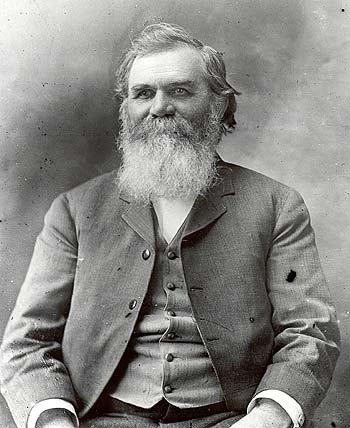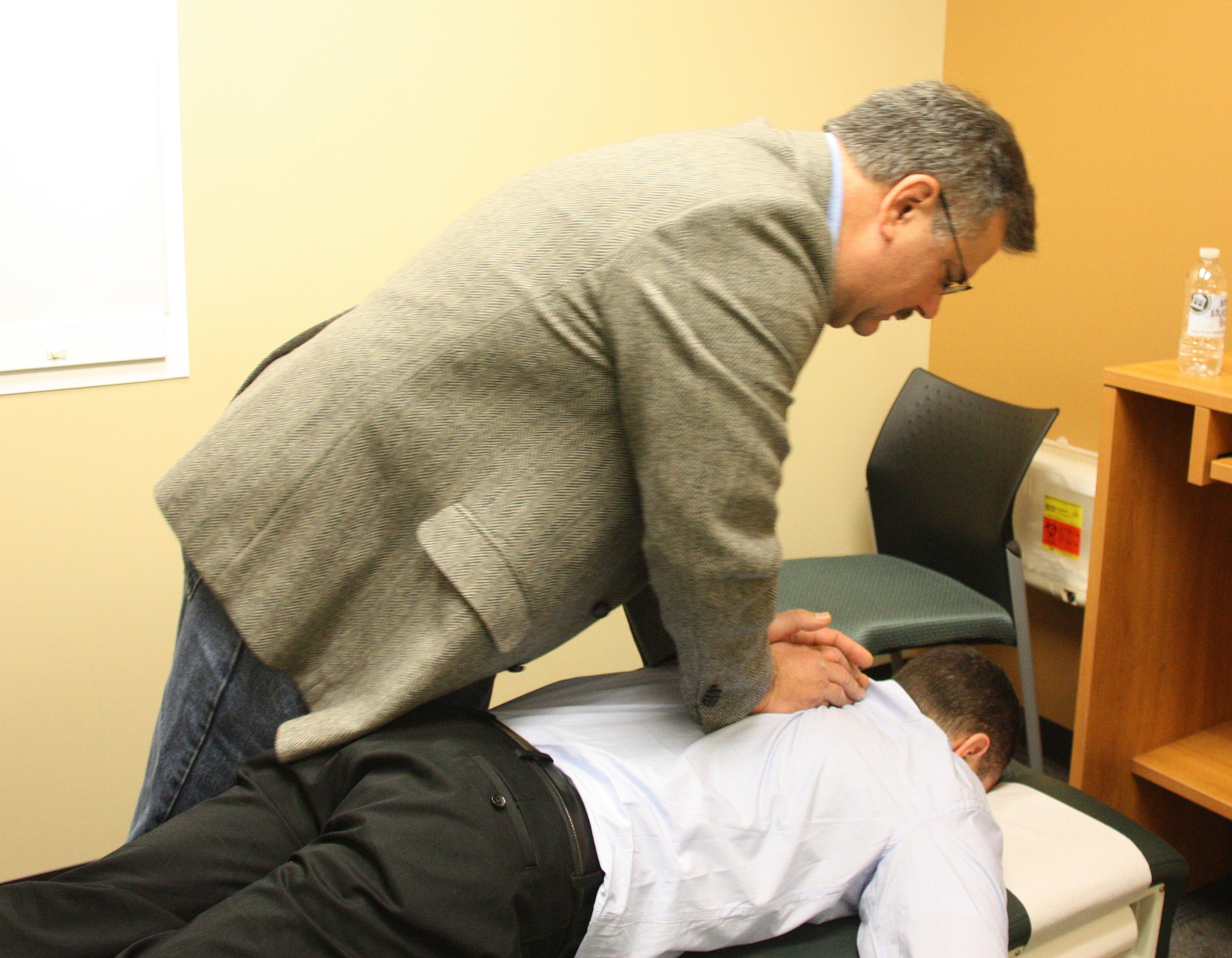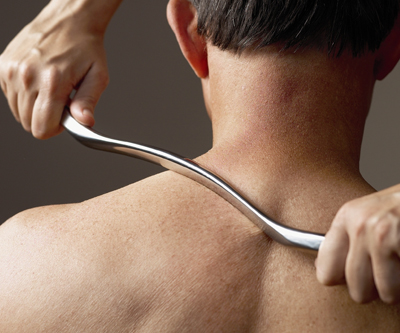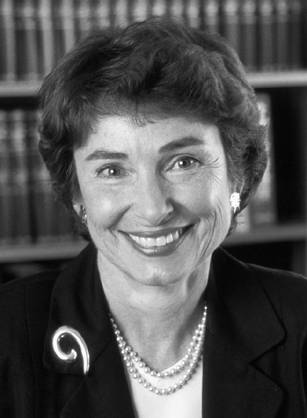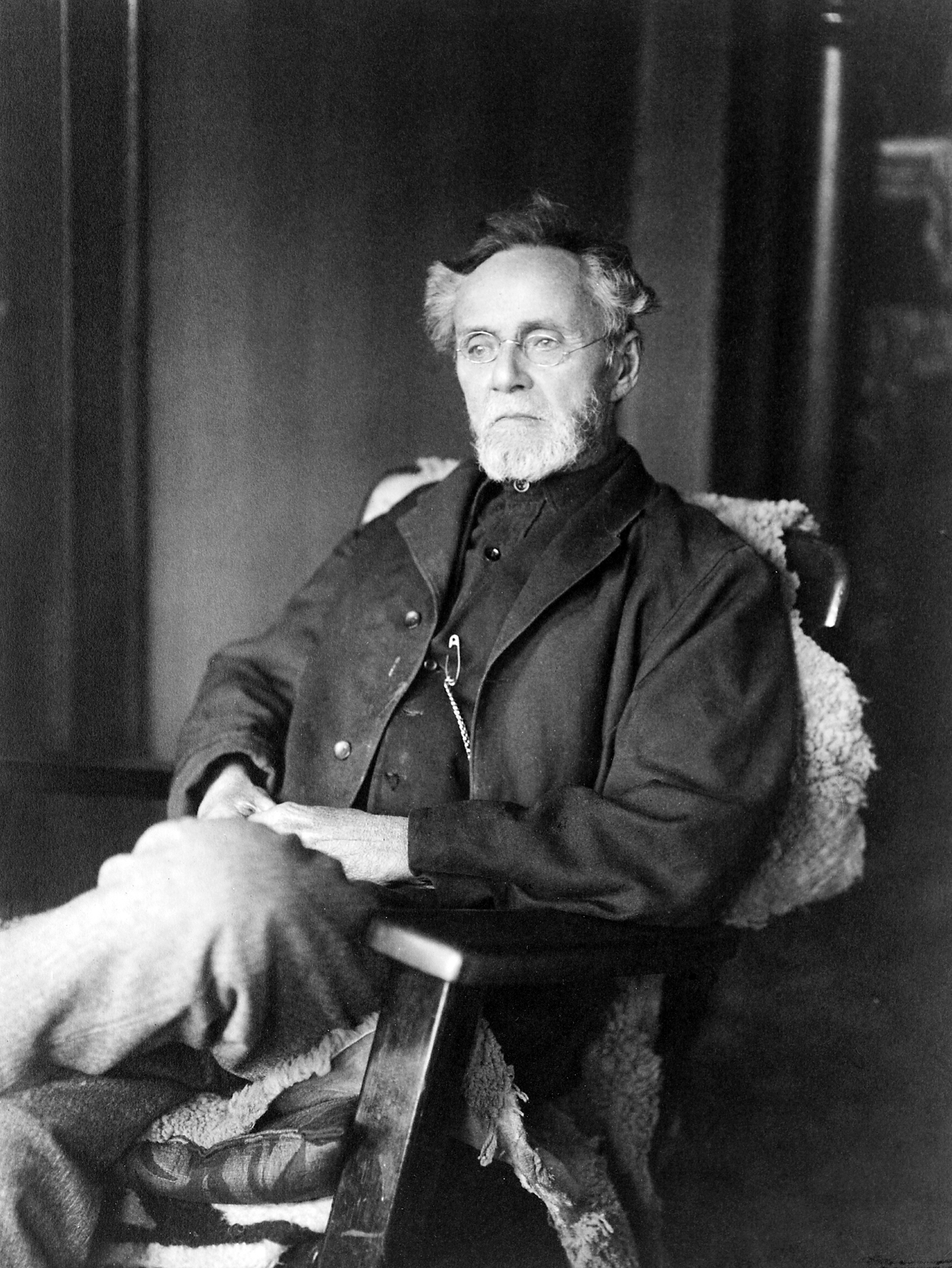|
Chiropractor
Chiropractic () is a form of alternative medicine concerned with the diagnosis, treatment and prevention of physical disorder, mechanical disorders of the musculoskeletal system, especially of the vertebral column, spine. It is based on several Pseudoscience, pseudoscientific ideas. Many chiropractors (often known informally as chiros), especially those in the field's early history, have proposed that mechanical disorders of the joints, especially of the vertebral column, spine, affect general health, and that regular Spinal manipulation, manipulation of the spine (spinal adjustment) improves general health. The main chiropractic treatment technique involves manual therapy, especially manipulation of the spine, other joints, and soft tissues, but may also include exercises and health and lifestyle counseling. AHCPR Pub No. 98-N002. A chiropractor may have a Doctor of Chiropractic, Doctor of Chiropractic (D.C.) degree and be referred to as "doctor" but is not a Doctor of Medici ... [...More Info...] [...Related Items...] OR: [Wikipedia] [Google] [Baidu] |
Innate Intelligence
Throughout its history, chiropractic has been the subject of internal and external controversy and criticism. According to magnetic healer Daniel D. Palmer, the founder of chiropractic, "vertebral subluxation" was the sole cause of all diseases and manipulation was the cure for all disease. Internal divisions between "straights," who adhere strictly to Palmer’s original philosophy, and "mixers," who incorporate broader medical practices, have further complicated the profession’s identity. A 2003 profession-wide survey found "most chiropractors (whether 'straights' or 'mixers') still hold views of Innate Intelligence and of the cause and cure of disease (not just back pain) consistent with those of the Palmers". A critical evaluation stated "Chiropractic is rooted in mystical concepts. This led to an internal conflict within the chiropractic profession, which continues today." Chiropractors, including Palmer, were jailed for practicing medicine without a license. Palmer c ... [...More Info...] [...Related Items...] OR: [Wikipedia] [Google] [Baidu] |
Vertebral Subluxation
In chiropractic, a vertebral subluxation means pressure on nerves, abnormal functions creating a lesion in some portion of the body, either in its action or makeup (defined by D.D. Palmer and B.J. Palmer, founders of chiropractic). Chiropractors claim subluxations are not necessarily visible on X-rays. Chiropractic#Straights and mixers, Straight chiropractors continue to follow Palmer's tradition, claiming that vertebral subluxation has considerable health effects and also adding a visceral component to the definition. Most medical experts and some Chiropractic#Straights and mixers, mixer chiropractors consider these ideas to be pseudoscience, pseudoscientific and dispute these claims, as there is no scientific evidence-based medicine, evidence for the existence of chiropractic subluxations or proof they or their treatment have any effects on health. The use of the word ''vertebral subluxation'' should not be confused with the term's precise usage in medicine, which considers ... [...More Info...] [...Related Items...] OR: [Wikipedia] [Google] [Baidu] |
Chiropractic Manipulation
Spinal adjustment and chiropractic adjustment are terms used by chiropractors to describe their approaches to spinal manipulation, as well as some osteopaths, who use the term adjustment. Research has shown that chiropractic care is effective for musculoskeletal conditions. However, claims about treating non-musculoskeletal conditions are not supported by evidence. Spinal adjustments were among many chiropractic techniques invented in the 19th century by Daniel David Palmer, the founder of chiropractic. Claims made for the benefits of spinal adjustments range from temporary, palliative (pain relieving) effects to long term wellness and preventive care. Description A chiropractic adjustment intends to affect or correct a vertebral joint's alignment, motion, and/or function. Specifically, adjustments are intended to correct "vertebral subluxations", a non-scientific term given to the signs and symptoms that are said by chiropractors to result from abnormal alignment of vertebra ... [...More Info...] [...Related Items...] OR: [Wikipedia] [Google] [Baidu] |
Spinal Adjustment
Spinal adjustment and chiropractic adjustment are terms used by chiropractic, chiropractors to describe their approaches to spinal manipulation, as well as some osteopathy, osteopaths, who use the term adjustment. Research has shown that chiropractic care is effective for musculoskeletal conditions. However, claims about treating non-musculoskeletal conditions are not supported by evidence. Spinal adjustments were among many chiropractic techniques invented in the 19th century by Daniel David Palmer, the founder of chiropractic. Claims made for the benefits of spinal adjustments range from temporary, palliative (pain relieving) effects to long term wellness and preventive care. Description A chiropractic adjustment intends to affect or correct a vertebral joint's alignment, motion, and/or function. Specifically, adjustments are intended to correct "vertebral subluxations", a non-scientific term given to the signs and symptoms that are said by chiropractors to result from abnorma ... [...More Info...] [...Related Items...] OR: [Wikipedia] [Google] [Baidu] |
Doctor Of Chiropractic
Chiropractic education trains students in chiropractic. The entry criteria, structure, teaching methodology and nature of chiropractic programs offered at chiropractic schools vary considerably around the world. Accredited Doctor of Chiropractic programs include instruction in several academic areas including neurology, radiology, microbiology, psychology, ethics, biology, gross anatomy, biochemistry, spinal anatomy and more. Prospective students are also usually trained in clinical nutrition, public health, pediatrics and other health or wellness related areas. The entry criteria, structure, teaching methodology and nature of chiropractic programs offered at chiropractic schools vary considerably around the world, although in the United States programs are required to teach specific areas for accreditation purposes. A 2005 World Health Organization (WHO) guideline states regardless of the model of education utilized, prospective chiropractors without relevant prior health care ed ... [...More Info...] [...Related Items...] OR: [Wikipedia] [Google] [Baidu] |
Spinal Manipulation
Spinal manipulation is an intervention performed on synovial joints of the spine, including the z-joints, the atlanto-occipital, atlanto-axial, lumbosacral, sacroiliac, costotransverse and costovertebral joints. It is typically applied with therapeutic intent, most commonly for the treatment of low back pain. Effectiveness Back pain Clinical guidelines from different countries come to different conclusions with respect to spinal manipulation. A 2012 Cochrane review found that spinal manipulation was as effective as other commonly used therapies. A 2010 systematic review found that most studies suggest SM achieves equal or superior improvement in pain and function compared with other commonly used interventions for short-, intermediate-, and long-term follow-up. A 2019 systematic review concluded that SM produced comparable results to recommended treatments for chronic low back pain, while SM appeared to give improved results over non-recommended therapies for short ... [...More Info...] [...Related Items...] OR: [Wikipedia] [Google] [Baidu] |
Chiropractic Treatment Technique
Chiropractors use their version of spinal manipulation (known as chiropractic adjustment) as their primary treatment method, with non-chiropractic use of spinal manipulation gaining more study and attention in mainstream medicine in the 1980s. There is no evidence that chiropractic spinal adjustments are effective for any medical condition, with the possible exception of treatment for lower back pain. The safety of manipulation, particularly on the cervical spine, has been debated. Adverse results, including strokes and deaths, are rare. There are about 200 plus chiropractic techniques, most of which are variations of spinal manipulation, but there is a significant amount of overlap between them, and many techniques involve slight changes of other techniques. According to the American Chiropractic Association the most frequently used techniques by chiropractors are Diversified technique 95.9%, Extremity manipulating/adjusting 95.5%, Activator Methods 62.8%, Gonstead techniq ... [...More Info...] [...Related Items...] OR: [Wikipedia] [Google] [Baidu] |
Daniel David Palmer
Daniel David Palmer (March 7, 1845 – October 20, 1913) was a Canadian-born American spiritualist and activist best known for creating chiropractic. Palmer was born in Pickering Township, Canada West, but emigrated to the United States in 1865. He was also an avid proponent of pseudoscientific alternative medicine such as magnetic healing. Palmer opposed anything he thought to be associated with mainstream medicine such as vaccination. Palmer believed that the human body had an ample supply of natural healing power transmitted through the nervous system. He suggested that if any one organ was affected by an illness, it merely must not be receiving its normal "nerve supply" which he dubbed a "spinal misalignment", or subluxation. He saw chiropractic as a form of realigning to reestablish the supply. Early life Palmer was born in the hamlet of Brown's Corners (later Audley) of Pickering Township, in what is now Ajax, Ontario. His parents were Thomas Palmer and Katherine McV ... [...More Info...] [...Related Items...] OR: [Wikipedia] [Google] [Baidu] |
Bartlett Joshua Palmer
Bartlett Joshua Palmer (September 14, 1882 – May 27, 1961) was an American chiropractor. He was the son of Daniel David Palmer (D. D.), the founder of chiropractic, and became known as the "Developer" of chiropractic. Early life B. J. Palmer was born on September 14, 1882, the son of Daniel David Palmer (or "D.D."), the founder of chiropractic, in What Cheer, Iowa,BJ Palmer Chronology. 1882 (Sept 14): BJ Palmer is born in What Cheer (Rehm, 1980, p. 271; Gielow, 1981, p. 32) The Palmer family of six resided in the back of a grocery store that D.D. operated. In 1885, D.D.'s wife became sick and died, after which D.D. remarried several times. When D.D. had settled with a new wife, he moved the family to |
Alternative Medicine
Alternative medicine refers to practices that aim to achieve the healing effects of conventional medicine, but that typically lack biological plausibility, testability, repeatability, or supporting evidence of effectiveness. Such practices are generally not part of evidence-based medicine. Unlike modern medicine, which employs the scientific method to test plausible therapies by way of Guidelines for human subject research, responsible and ethical clinical trials, producing repeatable evidence of either effect or of no effect, alternative therapies reside outside of mainstream medicine and do not originate from using the scientific method, but instead rely on testimonials, anecdotes, religion, tradition, superstition, belief in supernatural "Energy (esotericism), energies", pseudoscience, fallacy, errors in reasoning, propaganda, fraud, or other unscientific sources. Frequently used terms for relevant practices are New Age medicine, wikt:pseudo-medicine, pseudo-medicine, unortho ... [...More Info...] [...Related Items...] OR: [Wikipedia] [Google] [Baidu] |
Osteopathy
Osteopathy is a pseudoscientific system of alternative medicine that emphasizes physical manipulation of the body's muscle tissue and bones. In most countries, practitioners of osteopathy are not medically trained and are referred to as osteopaths. It is distinct from Osteopathic medicine in the United States, osteopathic medicine, which is a branch of the medicine, medical profession in the United States. Osteopathic manipulation is the core set of techniques in osteopathy. Parts of osteopathy, such as craniosacral therapy, have been described by ''Quackwatch'' as having no therapeutic value and have been labeled by them as pseudoscience and quackery. The techniques are based on an ideology created by Andrew Taylor Still (1828–1917) which posits the existence of a "myofascial continuity"—a tissue layer that "links every part of the body with every other part". Osteopaths attempt to diagnose and treat what was originally called "the osteopathic lesion", but which is n ... [...More Info...] [...Related Items...] OR: [Wikipedia] [Google] [Baidu] |
Vitalism
Vitalism is a belief that starts from the premise that "living organisms are fundamentally different from non-living entities because they contain some non-physical element or are governed by different principles than are inanimate things." Where vitalism explicitly invokes a vital principle, that element is often referred to as the "vital spark", "energy", "'' élan vital''" (coined by vitalist Henri Bergson), "vital force", or "''vis vitalis''", which some equate with the soul. In the 18th and 19th centuries, vitalism was discussed among biologists, between those who felt that the known mechanics of physics would eventually explain the difference between life and non-life and vitalists who argued that the processes of life could not be reduced to a mechanistic process. Vitalist biologists such as Johannes Reinke proposed testable hypotheses meant to show inadequacies with mechanistic explanations, but their experiments failed to provide support for vitalism. Biologists now ... [...More Info...] [...Related Items...] OR: [Wikipedia] [Google] [Baidu] |

